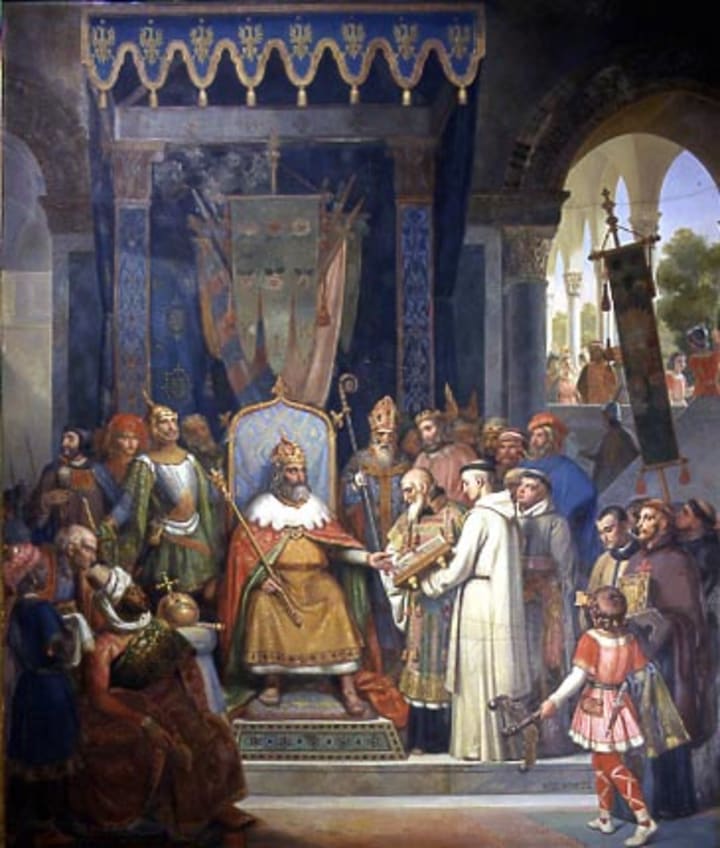What is a Paladin?
And Are They All Knights in Shining Armor?

When you hear the word paladin a certain vision comes to mind; a knight in burnished armor, standing tall on a field of challenge and awaiting his opponent. Perhaps he's astride a white charger, getting ready to do battle with the forces of evil. The word itself tends to refer to champions of honor, duty, and whose inherent goodness is displayed in their acts...
Or does it?
Like many modern words that have seen changes over time, a paladin was not originally an idea or an ideal; it was a very specific person. In its original incarnation the term could only be claimed by twelve knights in all of Christendom, and those twelve knights were some of the strongest, and most powerful warriors in the realm.
For those looking for more articles about language, history, and general geekery, such as What Does "Blood is Thicker Than Water" Really Mean? or Secret Societies: Who Were The Assassins? then you should take a moment to stop by my full Vocal archive to take a look around!
It All Started With Charlemagne

This whole linguistic exercise began with King Charlemagne, or Charles the Great as he was later called. Born in the mid-700s, according to History World, Charles was one of the only men to ever unite Germany and France under a single kingdom, excluding Napoleon's "short" stewardship of both countries. A talented warrior, Charlemagne led most of his military conquests from the fore of his army, and he built his kingdom in blood and steel cemented with guts and glory. Over time his empire grew so large that he required administrators to run things, and given that Christian missionaries were the only ones that had any education at the time, they were the ones that got the job. This led to one of the largest examples of the expansion of Christianity in Europe, and it had a far-reaching impact on how said religion was received all across Europe.
The truth of the matter is that while Charlemagne was a fantastic warrior and a brutal tactician who spoke a number of languages, he was also illiterate for much of his life. However, Charles the Great made a perfect mold for those looking for heroes to portray from the Medieval period when writing about the past during the Renaissance in the 1500s and 1600s. This required cleaning up Charlemagne's image a little bit, and after the authors of the day wiped the blood from his fists and touched up his smile, Charlemagne became widely regarded as the King of the Christian Franks.
Every King Needs Champions

Every king has his retainers, and Charles the Great had his twelve peers; his paladins according to the Online Etymology Dictionary. These men were his captains, the elites of his forces, and they included men like Roland and his companion Oliver who slew the enemies of the empire by the score (if you believe the myths these knights grew into, at least). They were a fine retinue to accompany any king in a Medieval romance, as well as to lead the divisions of his great army throughout history.
Now the word paladin officially came into common use in the 1590s, long after the broadsword had given way to the gun and the rapier. There were different versions of the word as well, including Latin, French, and Italian terms, and the Italian is what came out ahead because it was the Italian poets who were writing epics that made crushing in the skulls of other men sound like something to be admired. The literal translation referred to a servant of the palace, or to a palace official, and let's face it you couldn't get any more official than king's right hands.
But who were they? Though many great knights have been named to the Twelve Peers, there isn't a single, definitive list. As the stories grew and changed different noble personages were put into the roles of these elite commanders. Perhaps the only members of the Twelve Peers who appear in every story without fail are Roland (the commander of the Twelve and Charlemagne's own nephew) and his companion Oliver (a fierce knight who was second only to Roland in prowess and skill).
A list of common members of the Twelve Peers, along with links to their own individual stories, may be found below at Timeless Myths.
So How Did Paladins Become Holy?
Paladins are more often than not thought of holy warriors, often modeled after the Knights Templar and other church-backed organizations of warriors. The most common reason for this is that the historical touch-up done to make Charlemagne into the ruler of the Christian Franks likely extended to his Twelve Peers. After all, if Charlemagne was a faithful and holy king, then it followed that his men would be paragons of knightly honor. While glory and body count would have been much more important to the knights who actually fought under Charlemagne, when the legend gets too big, no one's much interested in the facts concerning what happened.
Did You Know...?
Another of the gifts Charlemagne has given us is the acclaimed actor Christopher Lee. Lee was a descendant of Charles the Great, and he's even named his metal band after his famous ancestor.
For more on that subject, check out 5 True Facts About Christopher Lee!
About the Creator
Neal Litherland
Neal Litherland is an author, freelance blogger, and RPG designer. A regular on the Chicago convention circuit, he works in a variety of genres.
Blog: Improved Initiative and The Literary Mercenary






Comments
There are no comments for this story
Be the first to respond and start the conversation.